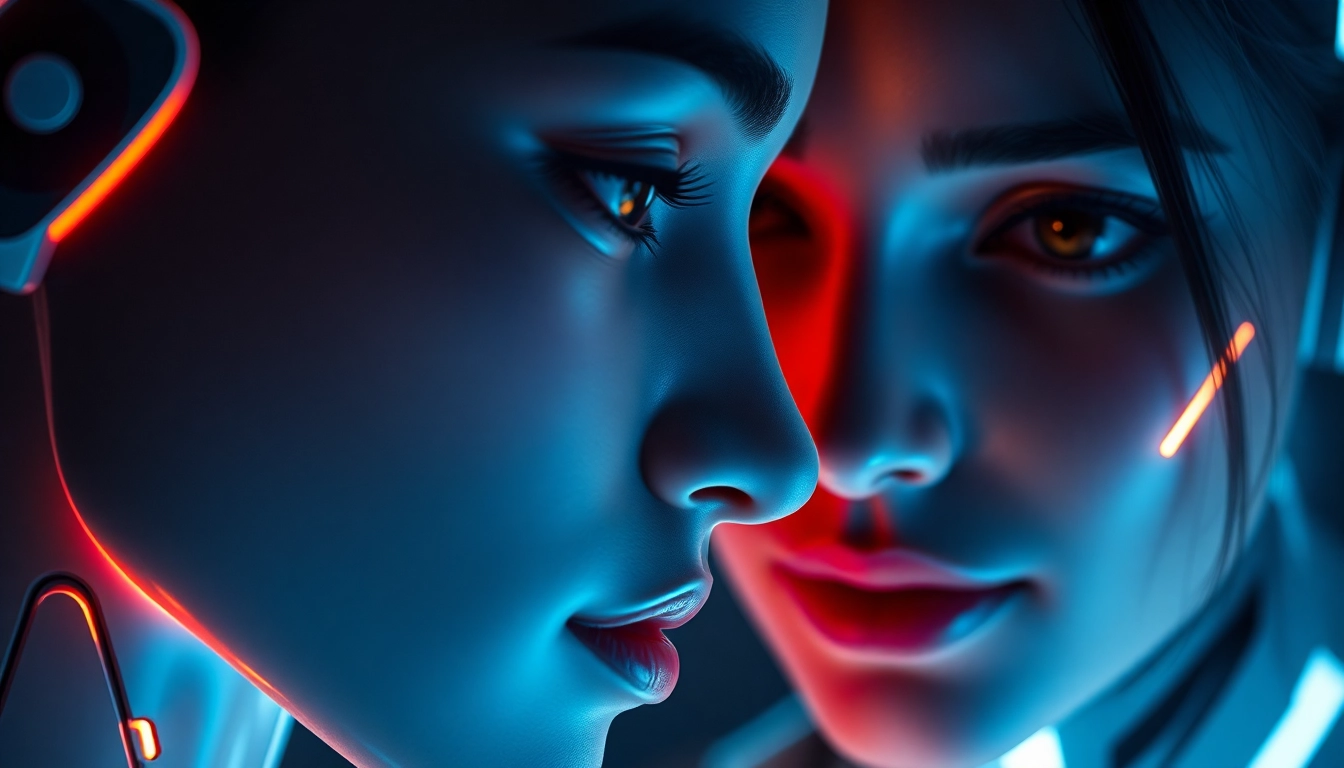Introduction to Ai sex: What it is and why it matters
Artificial Intelligence (AI) has permeated various aspects of human life, transforming industries, redefining social interactions, and challenging ethical norms. Among the latest and most controversial applications is Ai sex, a term that encompasses a broad range of digital and robotic intimate experiences powered by advanced AI technologies. As AI-driven companionship and intimacy tools become increasingly sophisticated, their societal implications—both positive and negative—have garnered widespread attention. Understanding what Ai sex entails, how it has evolved, and why it is a pivotal topic today is essential to navigating its future trajectory and addressing the associated ethical challenges.
Defining Ai sex and its evolution over recent years
Ai sex refers to the use of advanced artificial intelligence systems to simulate human-like sexual and romantic interactions. These can take the form of chatbots, virtual avatars, or physical robots designed to emulate human intimacy with unprecedented realism. The evolution of Ai sex has been driven by rapid advancements in natural language processing, machine learning, computer vision, and haptic feedback technologies.
Initially, AI companions existed as simple virtual chatbots with limited conversational capabilities. Over recent years, these systems have evolved into complex entities capable of engaging in nuanced emotional conversations, adjusting behaviors according to user preferences, and even learning from interactions to improve their responses. The development of AI sex robots, often equipped with realistic synthetic skin and articulated limbs, marks another milestone—blurring the boundary between digital and physical intimacy.
Demand for such products has been fueled by a variety of societal factors, including increased loneliness, technological acceptance, and changing attitudes toward sexuality. As the industry matures, Ai sex is no longer just a niche novelty but an expanding market with significant consumer interest across diverse demographics.
Current applications and popular platforms
Today, the landscape of Ai sex is populated by numerous platforms and devices designed to cater to various preferences. Replika, for example, is one of the most prominent AI companionship apps, boasting over 30 million users who create personalized digital partners. Such platforms enable users to engage in conversational intimacy, share thoughts, and explore romantic role-plays through text and voice interactions.
Physical AI sex robots—like those developed by companies such as RealDoll and Harmony—offer lifelike appearances, customizable features, and even AI-driven personality traits. These robots are often integrated with VR and haptic feedback devices to create immersive experiences that simulate real-world intimacy.
Online communities and apps specifically dedicated to erotic AI chat, such as DroFingo, offer customizable scenarios and characters, allowing users to indulge in sexually explicit conversations safely and discreetly. This proliferation of platforms underscores the diverse applications of Ai sex, from companionship and entertainment to experimental and therapeutic uses.
User demographics and societal interest
The user base for Ai sex spans a broad spectrum. While initially associated with tech-savvy, younger demographics, recent data indicates increasing interest among a wider age range, including older adults seeking companionship or intimacy solutions. Factors like social isolation, geographic dispersion, and mobility challenges contribute heavily to usage patterns.
Societally, the interest varies along cultural, legal, and ethical lines. While some view Ai sex as a means to enhance personal well-being and bridge intimacy gaps, others raise concerns about perpetuating loneliness, social withdrawal, or fostering unhealthy attachments. The debate has garnered media attention, prompting regulatory scrutiny and ethical debates worldwide. Nonetheless, the market is projected to grow exponentially, driven by technological innovation and shifting societal attitudes towards sexuality and digital intimacy.
The technology behind Ai sex: How it works
Key components: AI chatbots, virtual avatars, and deep learning
At the core of Ai sex technology lie several sophisticated components working in tandem. AI chatbots utilize natural language processing (NLP) algorithms—like GPT models—to produce human-like, contextually relevant responses. These chatbots are designed to simulate emotional connection, adapt to user preferences, and maintain engaging conversations.
Virtual avatars, whether 2D or 3D, provide visual representations that enhance the realism of interactions. Advanced computer vision and graphic rendering technologies enable these avatars to display facial expressions, gestures, and even lip-syncing synchronized with speech. Deep learning allows these systems to learn from interactions, improving their responses over time and adjusting to individual user behaviors.
Deep learning, especially through neural networks, drives the core of these intelligent systems, enabling them to understand complex nuances of human language and emotion. Combined with speech synthesis and voice recognition, AI chatbots can simulate more natural, compelling conversations that approximate real human interactions.
Development challenges and ethical considerations
Despite rapid technological progress, developing realistic Ai sex systems faces multiple challenges. Ensuring safety and preventing harmful outputs is paramount, particularly given concerns about AI manipulation or misuse. Responsible AI development demands strict filtering mechanisms to prevent offensive or abusive communication.
Ethically, issues around consent, emotional dependency, and potential exploitation are hotly debated. For instance, creating highly realistic avatars raises questions about how these entities should be represented legally and ethically—should they have rights or protections? Additionally, ensuring user privacy and data security remains a critical concern, especially when dealing with sensitive intimate interactions.
Balancing innovation with regulation involves navigating complex legal landscapes that differ worldwide, with some jurisdictions imposing bans or restrictions while others pursue more permissive approaches.
Integration with VR and haptic devices for immersive experiences
To transcend traditional text or static images, modern Ai sex experiences often incorporate virtual reality (VR) headsets, haptic feedback suits, and robotic components. VR immerses users into a simulated environment where they can interact with digital avatars in three-dimensional space, intensifying the sense of presence and realism.
Haptic devices provide tactile feedback, enabling users to feel touches, textures, and movements, thereby deepening emotional and physical engagement. Robotic components, such as AI-powered sex dolls, respond to user interactions with programmed movements, heat, and responsiveness that mimic human behavior.
These immersive combinations are pushing the boundaries of digital intimacy, offering experiences that are increasingly close to real-life encounters, thereby opening new avenues for therapy, companionship, and entertainment.
Benefits and opportunities of Ai sex technology
Enhancing personal intimacy and companionship
One of the primary promises of Ai sex technology is its potential to enhance personal intimacy. For individuals experiencing loneliness, social anxiety, or difficulty forming traditional relationships, AI companions offer a safe, judgment-free environment for connection and emotional expression.
AI-driven entities can serve as substitutes or supplements to human relationships, providing comfort, conversation, and companionship without the complexities of human social dynamics. This can be particularly valuable during periods of grief, illness, or social isolation—offering a form of emotional resilience and mental health support.
Furthermore, AI companions can be tailored to individual preferences, fostering a sense of genuine emotional attachment that supports mental well-being and personal development.
Personalization and emotional connection
Unlike traditional sex toys or static avatars, Ai sex platforms leverage machine learning to personalize interactions deeply. Users can customize appearance, personality traits, speech patterns, and even emotional responses, leading to more meaningful connections.
This personalized approach cultivates a sense of understanding and emotional intimacy, which many users find more fulfilling than generic experiences. AI systems can remember past conversations, preferences, and even milestones, fostering a sense of continuity and genuine relationship building.
Emerging research suggests that such tailored interactions may support therapeutic goals, such as addressing trauma or aiding social skills development, especially among vulnerable populations.
Addressing social isolation and mental health
As societal trends toward increased social isolation grow—exacerbated by urbanization, digital dependence, and global crises like pandemics—Ai sex offers a potential tool to mitigate loneliness and mental health issues.
Clinical studies indicate that virtual companionship can improve mood, reduce anxiety, and provide a sense of purpose. While Ai sex should not replace human relationships, its strategic use can complement traditional mental health support and fill critical gaps where human contact is limited.
Nevertheless, integrating such technologies responsibly requires ongoing research and ethical oversight to prevent overdependence and ensure that they support holistic well-being rather than exacerbate social detachment.
Risks, concerns, and regulatory landscape
Potential misuse and safety issues
Despite its benefits, Ai sex technology is plagued by significant risks. Malicious actors could exploit these systems for coercive, manipulative, or abusive purposes. The creation of deepfake-style explicit content, especially involving minors or non-consenting individuals, heightens risks of exploitation and cybercrime.
Recent reports highlight the danger of AI tools being used to generate illicit imagery or facilitate grooming behaviors, prompting urgent calls for robust safety protocols and moderation tools. For instance, AI-generated child sexual abuse material (CSAM) has emerged as a disturbing consequence of advances in deepfake and synthetic media technologies.
Ensuring user safety involves implementing strict content filtering, user verification, and transparency in AI training data. Moreover, developers must collaborate with law enforcement agencies and NGOs to combat abuse effectively.
Legal and ethical debates surrounding consent and exploitation
The legitimacy of AI entities engaging in sexual or romantic roles raises complex ethical and legal questions. Should AI companions possess rights or protections? What constitutes consent in a virtual scenario? These debates are ongoing and often culturally context-dependent.
Additionally, there are concerns that AI sex robots could reinforce harmful stereotypes, perpetuate unrealistic expectations about body image and relationships, or foster dependency at the expense of genuine human connection.
Legislators across the globe grapple with establishing regulations that balance innovation with societal protection. Some jurisdictions have already imposed bans or restrictions, while others promote responsible industry standards.
Current regulations and industry standards
Regulatory approaches vary globally. For example, some countries have enacted laws restricting the sale of certain AI sex robots, especially those deemed potentially unethical or dangerous. Others promote voluntary standards aimed at content moderation, ethical development, and user privacy.
Industry standards tend to focus on transparency, user safety, and restrictions on content that involves minors or non-consensual scenarios. Companies are increasingly adopting ethical guidelines to navigate legal ambiguity and societal expectations.
Staying compliant requires ongoing monitoring of legal developments and active participation in industry forums that define best practices.
Future outlook and responsible development
Emerging trends and technological advancements
The future of Ai sex is poised for rapid evolution. Advancements in artificial intelligence will lead to even more sophisticated, emotionally intelligent, and immersive virtual companions. Integration with augmented reality (AR), brain-computer interfaces, and advanced robotics will redefine the possibilities of digital intimacy.
Emerging trends include the development of neuro-responsive AI that can adapt instantaneously to user mood and intention, creating a seamless, deeply personalized experience. Blockchain technology might be utilized to ensure data privacy and secure ownership of digital assets like avatars or virtual spaces.
Furthermore, cross-disciplinary collaborations between AI developers, psychologists, ethicists, and lawmakers will be essential to guide responsible innovation.
Industry responsibilities and ethical guidelines
Developers and industry stakeholders bear a significant responsibility to prioritize safety, transparency, and ethical integrity. Establishing industry-wide guidelines for ethical AI behavior, content moderation, and user protection is vital.
Efforts should include transparent AI training practices, clear disclaimers on AI limitations, and mechanisms to report abuse or unethical content. Companies must also invest in ongoing research to understand the social impact of their innovations.
Encouraging diversity among developers and involving community feedback can foster the development of more equitable, respectful AI systems.
How users and developers can foster healthy innovation
While technological progress is inevitable, fostering a culture of responsible innovation is key. Users should be educated about AI capabilities and limitations, emphasizing ethical use and respectful engagement.
Developers can incorporate safety-by-design principles, conduct thorough testing, and engage with ethicists to mitigate harms. Public dialogue and stakeholder participation are crucial to aligning product development with societal values.
Ultimately, creating AI systems that serve human needs while respecting dignity and rights will determine whether Ai sex becomes a force for positive societal change or a source of controversy and harm.


